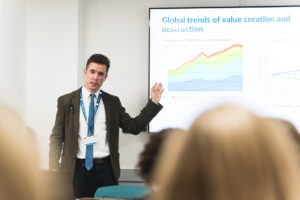
| Date | Author |
|---|---|
| 25th May 2022 | David Becker, Managing Consultant, SUMS Consulting |
Target Operating Models (TOMs), and their design and implementation, are a journey that require dedication and attention. Here, SUMS Managing Consultant David Becker explores how to make a TOM more impactful in the world of higher education along with outlining what pitfalls you need to avoid.
A New Player in Town
The Higher Education sector has always enjoyed an acronym. I still remember my confusion when I first joined a university, constantly asking trusted colleagues for their help in differentiating my RAEs from my REFs and learning my HEFCEs and my HESPAs.
Now there’s a new acronym in town – and there are a lot of good reasons why it’s a subject of interest. That new acronym takes the form of a Target Operating Model – the TOM. You can read my previous article ‘Getting Where You Need to Be: Target Operating Models for Universities’ here which discusses the merits of universities developing Target Operating Models.
If you have the collective will and appetite, then a well-designed, evidence-based and fully executed TOM could improve your delivery to a greater level than you ever thought possible. But genuine TOM design and implementation is not a quick fix, nor is it a journey for the faint-hearted.
Making TOMs Impactful in the World of Higher Education
Target Operating Models aren’t actually new at all but the application of them in a way which consistently works in this sector most definitely is.
We emphasise this point because we believe it is fundamentally impossible to take textbook definitions of a TOM – the sort you commonly find outlined when you do a Google search or read through your Business Model Canvas – and apply them to a university in the same way you might be able to in a commercial organisation, or even in other parts of the public sector. Put simply, there is a limited pool of people in a university who are willing and able to muster up enthusiasm for business architecture in the form of ‘perspectives across the value chain’ or ‘modelling of business capabilities’.
I don’t want to denigrate these concepts. They’re part of what we’re trained in, and meaningful business change can’t take place without them. A sensible starting point, though, is one which recognises that much of the language around TOMs is so unnecessarily heavy on jargon – and so open to misinterpretation – that adopting an off-the-shelf approach is always likely to go down like a lead balloon in university circles.
Putting the language to one side, it’s entirely reasonable to say that every single organisation should have clarity about its current operating model and its target operating model, and universities are no different. In fact, we‘d argue that it’s a professional responsibility of every senior management team to ensure this is the case.
But why?
To answer that question, it’s worth unpacking what a TOM actually is. Let’s forget the technical language here. Essentially, a TOM is a description of an organisation’s ideal state. It’s how you want to do business. You can visualise it as the destination at the end of the bridge your university needs to cross to get from its current location (its ‘as is’) to its desired new one (its ‘to be’). Successful pursuit of any new operating model demands that you make a journey to cross that bridge. In the same way that a physical bridge is supported by engineering infrastructure that makes it safe and roadworthy, in an organisational sense, the bridge’s stability is dependent on your people, their capabilities, the business processes and IT systems, and structures that hold everything together. The key to high performance, however you choose to define it, lies in maintaining, optimising and coordinating all of these things effectively. If you can improve the way you do that then you’ll get closer to your desired destination much more quickly. And, bringing to mind the works of Isambard Kingdom Brunel, great bridges stand the test of time.
Whilst the TOM design and implementation process will certainly lead to leaner business processes and increased satisfaction metrics, it will also accelerate delivery of your strategy because every aspect of your infrastructure will have been specifically designed to support it, rather than simply being a by-product of decades of individual preference, constant structural changes, and ad-hoc sticking plasters.
A good TOM will transform your operations – IF you can win the long-term battle against preference for the status quo, IF you ensure you partner the design with meaningful implementation, and IF you acknowledge that a sound approach to TOM design means the journey never really ends.
The Pitfalls You Need to Avoid
It’s really important to understand what a TOM is not.
Firstly, it is not your university’s organisational structures. This is the most common misconception we see. It’s easy to work out why. Structures are accessible. You can see them on a piece of paper or a slide. You can quickly throw around ideas (“there are administrative functions in the colleges as well as in the central services, that can’t be the best way of doing things”). The truth is that a university can draw its organisational boundaries almost anywhere it chooses. Yes, those structures can sometimes act as a barrier to agile decision-making, or blur the boundaries between who is responsible for what, or lead to much higher levels of management cost – but none of that is a given. Over the years, we’ve seen just as much opportunity for improvement in highly centralised institutions as we have in highly devolved ones. A TOM is certainly likely to tackle structures as part of its considerations but it’s only a relatively small part of the bigger picture and any changes made are unlikely to be static. Which leads me on to our second misconception.
A TOM is not something you design and deliver once and then stop. The same shifting sands in this sector which might have prompted you to create one in the first place are also the reason why your TOM must keep evolving. Talking about an ideal ‘end state’ can imply that there’s a point at which the TOM journey stops, but we prefer to think of sound operating model design as a continuous journey. How can it be any other way in a world that is evolving so quickly? As such, a well-managed institution is one which is likely to recognise the benefits of continuously updating and pursuing its target state. To revert to the engineering analogy, bridges need to be maintained in order to remain roadworthy. For this reason, the skills and capabilities necessary to develop a TOM need to become embedded in your institution. A consulting firm can inject technical expertise, pace, energy and skills transfer, but the latter is probably the most important of the lot.
A TOM is not simply a glossy pack of slides and diagrams which everyone congratulates themselves on completing and is then promptly filed away in a dusty cabinet to never see the light of day again. If you’re going to embark on the TOM journey, then it needs to come with a commitment that the TOM is a living model that becomes part of the culture and working life of your University.
Finally, an operating model which has financial efficiency hard baked into it is vital. And yes, the process of designing and implementing your TOM is highly likely to identify and generate cash savings. But if you see the sole purpose of developing a new TOM in a university as simply reducing short or medium-term cost pressures, you need to re-evaluate your expectations. The desired TOM should not be confused with a desired level of operating surplus. Or contribution figure. A newly designed and implemented TOM will most likely require some up-front investment, both in financial terms, as well as – and this is trickier to quantify – the time and energy of your staff, not least your leaders, and people managers who will need to prepare the way, advocate for change and role model new ways of working long after the consulting team have left the building.
Exhausted just thinking about a new TOM? You should be! The design, development, implementation and embedding of a target operating model is not for the faint hearted, and it’s so important to be honest about that from the outset. However, when done right, the benefits for a university and its long-term sustainability far outweigh the short-term pain. There are hundreds and thousands of organisations across other sectors that can attest to the benefits.
Further Information
SUMS has a team of consultants who are expert in the field of organisation design and in the development and execution of target operating models. They combine deep sector knowledge with senior level experience from outside of the sector gained from working in global commercial consultancies, within retail, commerce and other complex sectors such as the NHS.
Our blended consulting teams help ensure that SUMS retains its USP as a not-for-profit consultancy that truly understands the nuances of the higher education sector, whilst also allowing us to identify the latest knowledge and innovation from outside the sector and across the globe and deploy it to the benefit of our clients.
We are always happy to discuss approaches to TOM design, and to guide your thinking, free of charge. Please contact David Becker, Managing Consultant, at d.becker@reading.ac.uk if you would like to learn more.
Stay tuned for David’s next post on TOMs, exploring the tensions, benefits and ultimate impact the right TOM can have for your university.








